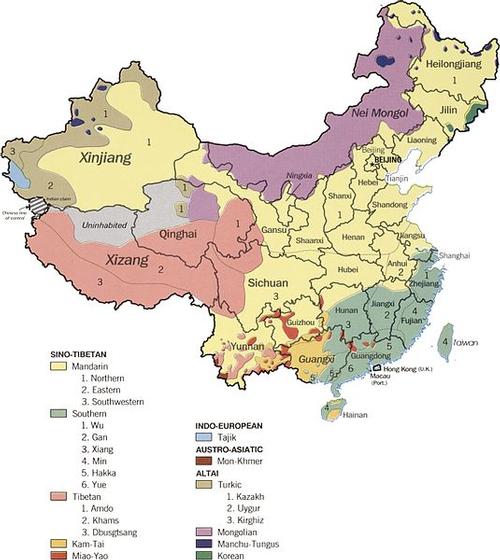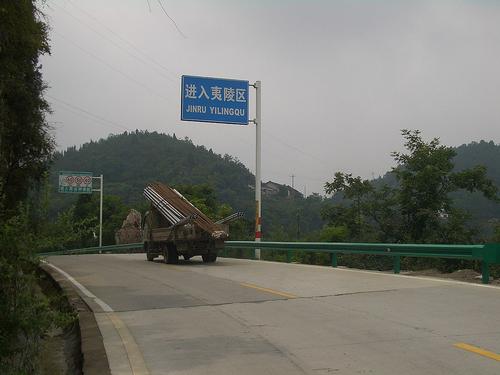CHINA
Language

Language

Cities in CHINA
| Beijing |
Language
General
 Languages in ChinaPhoto: Public domain
Languages in ChinaPhoto: Public domain
The official language of China is Standard Mandarin (Putonghua or Guoyu), the base dialect of Northern China. This language is understood by the majority (approx. 70%) of the residents of the People's Republic of China (70%). Each province has its own 'dialect'; many of them, such as those spoken in Hunan and Guangdong provinces, could even be called official languages. Furthermore, all major minority peoples, with the exception of the Hui, have their own language.
Since 1958, standard Mandarin has been promoted as a spoken language for all of China through schools and radio. Simplification of Chinese characters is also continuing. The simplified romanization or phonetic transcription of the Chinese characters, the so-called Hanyu-Pinyen spelling, was officially accepted on January 1, 1979.
The Chinese language belongs to the Sino-Tibetan language family, in particular to its Sinitic branch. This Sinitic branch can be divided into seven dialect groups: Mandarin Chinese, Cantonese (Yuè), Min, Hakka (Kèjiâ), Wú, Gàn and Xiâng.
Dialects
The Mandarin Chinese dialects are very closely related and are spoken from Northeast China to 4000 km south in Yunnan. Beijing-Chinese, on which the standard language is based, belongs to this group.
Cantonese (Yuè) from Guangdong, with the capital Canton, is considered the unofficial standard language among Chinese outside China.
In the isolated province of Fujian, the Min dialects have developed relatively independently, giving some features a unique perspective on older language phases.
Hakka (Kèjiâ) is spoken in northern Guangdong and in a number of smaller South China areas. The Hakka population is probably descended from North Chinese migrants, but given the similarities with the Min and Cantonese, Hakka linguistically belongs in South China.
The Wu dialects are mainly spoken in Zhejiang and Jiangsu, south of the mouth of the Yangzi Jiang. The metropolis of Shanghai is also located in this area.
In Jiângxî and the eastern part of Hunan the Gan dialects are spoken; in the rest of Hunan people speak Xiang.
Classical Chinese
Classical Chinese or Wényán is the language in which almost all Chinese texts were written until the twentieth century. Wényán was the written language of the officials, which was already introduced during the Qin dynasty (221-206 BC) and mainly served to put official documents in writing. At that time, Baihua was the everyday spoken language, the language of the "living dialects". The emperors of the Sui and Tang dynasties imposed on all officials in the empire the use of the North Chinese dialect of Beijing (Mandarin). Since the Yuan Dynasty, this has been considered the General Civilized Chinese.
The syntax and vocabulary are based on the spoken language of the Period of the Warring States (4th-3rd century BC). However, the writing language was already somewhat stylized at that time, especially in the vocabulary.
Because all homophonic forms can be distinguished in writing, Classical Chinese developed into a very concise but artificial writing language and therefore has no sound of its own. Traditionally, the local pronunciation that is valid at that time is used everywhere in China for reading.
Default language
The need for a living standard language dates from the period of social and political division at the beginning of this century. At that time, voices were raised to make the Beijing dialect, the metropolitan norm of the past centuries, the standard. Nevertheless, an artificial pronunciation standard was promulgated in 1919 and was not replaced by the Pekinese pronunciation until 1932.
The syntax and vocabulary of the standard language are those of the Mandarin Chinese dialect group. This language is considered standard in both the People's Republic of China and Taiwan. Both countries do have their own name for the standard language: the original name Guóyu (or Kuo-yü, 'National Language') has been retained in Taiwan, but on the mainland the language is called Putônghuà ('General Language').
As a written standard, after the Literary Revolution of 1919, Classical Chinese was replaced by Báihuà, the modern writing language.
Pinyin
 In Yiling, Yichang, Hubei, road sign texts are in Chinese and in Hanyu PinyinPhoto: Vmenkov CC 3.0 Unported no chnges made
In Yiling, Yichang, Hubei, road sign texts are in Chinese and in Hanyu PinyinPhoto: Vmenkov CC 3.0 Unported no chnges made
The Chinese script dates from around 5000-4000 BC, is considered the oldest written language in the world and has no less than 50,000 characters. An average Chinese only uses about 3000-4000 characters, someone with a good education needs 6000-8000. 2000-3000 characters are sufficient to read a newspaper.
The Chinese script has evolved from a pictorial or pictographic script with simple miniature images to an ideographic script with very stylized designs that one has to analyze in order to understand them. The Chinese characters do not give a precise indication of the pronunciation, so the same script can be used quite easily across the country by speakers of different dialects.
In an attempt to reduce illiteracy, a widely accepted transcription system is now widely used to write the language in the Latin alphabet: the so-called Pinyin spelling. Furthermore, a system has been developed to simplify the most common characters. For example, in 2000 more than 2000 characters were simplified.
After the foundation of the People's Republic of China, massive campaigns were conducted for the spread of the script and of the Standard Mandarin. An official transcription standard was established in 1957 for the rendering of Standard Mandarin in the Roman alphabet: Hànyu Pinyin (literally: 'Transcription of Chinese'). Yet it was never the intention to replace the character script with this transcription.
Hànyu Pinyin, usually called Pinyin for short, is intended to write down the pronunciation when learning to write characters. Outside of China, the use of this transcription system for rendering Chinese words has become common since the 1980s. Hànyu Pinyin was recognized as a standard in 1982 by ISO, the Geneva International Standards Agency.
In addition, more than 30 script forms are in use in China. Of these, 20 have existed for hundreds of years, including Mongolian, Tibetan, Dai, Yi, Uighur, Russian and Manchurian. Others, such as the Zhuang language, which had no script of their own, were artificially created around 1950 based on the Latin alphabet.
The Pinyin system has 24 consonants, 15 vowels (and vowel combinations) and four characters for the important Chinese word tone. The pitch (flat, ascending, descending, descending-ascending) makes the character a different word and gives it a different meaning. In addition, there is another neutral tone, which is determined by the preceding tone.
The pronunciation of a character can be divided into: tone, initial sound and final sound. The meaning of a sound is determined by the tone of that sound and the tone sign is placed above the vowels.
For example, the syllable "ma" can mean "mother", "horse", "hemp" or "shrew" depending on the tone.
The Chinese language has no inflections and no masculine and feminine words. To indicate singular and plural, masculine and feminine, present and past tense, one must add numerals and adverbs (to a sentence). Past time is indicated by timing and an addition that indicates that the activity is already over.
Many Chinese words consist of two or more characters or monosyllabic words. For example, the Chinese word for film is "dian-ying" and consists of the words dian ("electricity") and ying ("shadow"). To make reading easier, Pinyin combines the syllables that make up one word.
Some words and phrases:
- Hello = ní hao
- Goodbye = zài jiàn
- Thank you = xiè xiè
- I do not understand = wo tingbudong
- A = yi
- Three = san
- Ten = shí
- Hundred = yi bai
- Water = shui
- Money = qián
- How much is it? = duo shao qián?
- Can you help me? = ni néng bangzhù wo ma?
- Today = jin tian
- Post office = yóu jú
- Eat tasty = mànmàn chi
- The bill, please = qing jie zhàng
- Is there someone who speaks English? = you méi you rén huì shuo ying wén
Sources
China
Cambium
China
Informatie Verre Reizen
Eijck, F. / Reishandboek China
Elmar
Floor, H. / China
Stichting Teleac
Harper, D. / China
Kosmos-Z&K,
Jansen, I. / China
Gottmer/Becht
Knowles, C. / China
Van Reemst
MacDonald, G. / China
Kosmos-Z&K
CIA - World Factbook
BBC - Country Profiles
Last updated June 2025Copyright: Team The World of Info